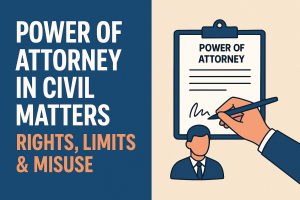The Indian Constitution guarantees personal liberty as a fundamental right under Article 21, yet the State is also empowered to restrict this liberty through preventive detention laws—a concept that has long been debated for its constitutional implications and potential for misuse.
This blog delves into the legal framework, judicial scrutiny, and the delicate balance between individual liberty and national security in India.
What is Preventive Detention?
Preventive detention means detaining a person without trial, not for what they have done, but for what they might do. It’s a pre-emptive measure used by the State to prevent individuals from acting in a manner deemed prejudicial to public order, national security, or economic stability.
In India, preventive detention is governed by laws such as:
- National Security Act, 1980 (NSA)
- Conservation of Foreign Exchange and Prevention of Smuggling Activities Act, 1974 (COFEPOSA)
- State-specific preventive detention laws
Constitutional Provisions
The Constitution of India recognizes preventive detention under:
- Article 22(3) to 22(7): While most arrested persons enjoy the right to legal counsel and being produced before a magistrate within 24 hours, these safeguards do not apply in preventive detention cases.
- Article 21: Any law allowing detention must satisfy the “procedure established by law” and must not be arbitrary or unfair (as per Maneka Gandhi v. Union of India, AIR 1978 SC 597).
Recent Supreme Court Observation
In a recent 2025 ruling, the Supreme Court struck down a preventive detention order passed under the Kerala Anti-Social Activities (Prevention) Act, 2007 (KAAPA), stating:
“Preventive detention laws must be used sparingly and strictly in accordance with constitutional safeguards. Personal liberty cannot be curtailed lightly.”
This reaffirms the court’s commitment to judicial oversight and the narrow interpretation of preventive detention laws, especially in cases of vague or mechanical detentions.
Legal Safeguards Against Misuse
While preventive detention laws inherently curtail liberty, there are built-in constitutional and statutory protections:
1. Advisory Board Review: A detained person must be presented before an advisory board (consisting of High Court judges) within 3 months.
2. Maximum Period of Detention: Cannot exceed 12 months unless extended.
3. Grounds of Detention: Must be communicated to the detenue to make an effective representation, unless disclosure harms public interest.
Judicial Principles
Indian courts have laid down stringent principles to evaluate preventive detention orders:
- Subjective satisfaction of detaining authority must be real and not mechanical.
- Delay in passing the order or supplying detention grounds invalidates the detention.
- Multiple grounds must be severable—one invalid ground can vitiate the entire detention.
Key cases:
- A.K. Gopalan v. State of Madras (1950)
- Maneka Gandhi v. Union of India (1978)
- Rekha v. State of Tamil Nadu (2011)
- Gautam Navlakha v. NIA (2023)
Challenges & Criticism
- Lack of transparency in detention decisions.
- Misuse for political purposes or preventive custody in minor offences.
- Absence of trial denies due process.
Way Forward: Balancing Security and Liberty
The doctrine of “constitutional balance” demands that security measures be proportional, reasoned, and legally justified. The solution lies not in abolishing preventive detention laws, but in narrowing their scope, improving judicial scrutiny, and ensuring strict compliance with procedural safeguards.
Conclusion
In a democracy governed by the rule of law, liberty is the rule and detention the exception. The Indian judiciary plays a crucial role in ensuring that preventive detention laws are not used as instruments of convenience, but only as tools of necessity—used sparingly, transparently, and constitutionally.



